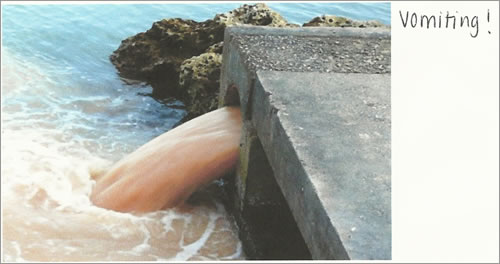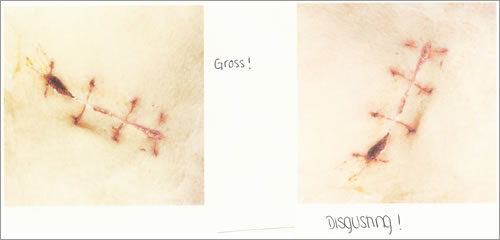Collaging: Getting Answers To The Questions You Don’t Know To Ask
When conducting user research, we all know that asking the right questions is just as important as how you ask them, but how do you know exactly what questions to ask? What if the discussion topic is very personal? How do you get a complete stranger to open up? There is a better way to conduct an in-depth interview, and it doesn’t involve a clipboard. Just imagine what you could discover if the participant’s answers weren’t limited to a predetermined set of questions. This is where collaging can help.
Collaging is a projective technique by which participants select images that represent how they feel about a particular topic. The participants then explain to the moderator the reason they chose each image. The collage becomes an instrument through which participants are able to express needs and feelings that they might not otherwise have been able to articulate. This information enables us to better understand the user’s world and how to design for it.
Further Reading on SmashingMag:
- Get Creative With Collage: Trends and Inspiration
- Up On The Wall: How Working Walls Unlock Creative Insight
- Art Manifestos and Their Applications in Contemporary Design
- Designing With Your Clients
A Picture Is Worth A Thousand Words
So, you might be asking yourself, “Why should I have people make collages, rather than just ask them point-blank questions about their needs and feelings?” It’s a great question, and the answer is, sometimes the most valuable answer is not in response to a direct question, but one that’s elicited. An image can be a powerful stimulus that evokes a strong response, triggers a memory and draws out feelings that exist below a person’s own level of awareness.
Gerald Zaltman, author of How Customers Think, states that “95% of our thoughts and feelings are unconscious.” There is just so much that we carry around in thought but never share until something triggers it. When we ask a participant a set of pre-defined questions, we are predetermining the scope of the interview. Instead, by presenting a visual stimulus, we are letting the participant start the conversation and bring up topics that are meaningful to them.
There are also times when you don’t know the right question to ask. Sometimes you do, but you don’t know how to ask it. Depending on what you’re researching, participants might have difficulty opening up to you. The research topic might be too personal, controversial or sensitive for the participant to just open up and start discussing with a complete stranger. The collage becomes a catalyst for discussion, an ice-breaker.
What You Can Learn
Collaging is a method of building empathy with your users. You gain an emotional understanding of the user’s feelings, problems, state of mind and so on, which is imperative to know when designing for them. Collaging can also help you better understand the user’s needs, in turn helping you to address them in your product.
The wonderful thing about this method is that participants might reveal stories that prompt a line of questioning about a topic that you never expected to explore (as we’ll see in the examples below). You honestly don’t know what you will learn from each participant’s collage.
A Brief History Of Projective Techniques
Collaging is not new. The method has been well used to conduct qualitative marketing research for at least 40 years. Its use in marketing has mainly been to assess feelings towards brands and products. Other projective techniques — tests such as the Rorschach, word and sentence completion, draw-a-person, and thematic apperception — date back to the early 19th century. All of these methods are rooted in psychology, but their application has expanded to other fields such as advertising, management, sociology, anthropology and, more recently, user experience (UX), to name a few. Collaging as a user research method has yet to be widely adopted in our industry, but I’ve seen a steady increase in its use and popularity over the past few years.
Conducting A Collaging Exercise
Listed below are all the steps necessary to conduct your own collaging study. Let’s walk through them together.
1. Choose Your Topic of Interest
The collaging exercise should focus on a specific topic. You will be asking participants to choose pictures that reflect how they feel about this topic. For example, if I were redesigning a website, I might ask the participant,
“Select pictures that reflect how you would and would not want the new website to greet you.”
You could word this in a lot of different ways, such as,
“Create a story about how you would want the website to communicate with you. What qualities should it have? What qualities should it not have?”
Or, to learn more about a participant’s day-to-day struggle with a problem, you could simply say,
“Select pictures that reflect your experience with using [x].”
2. Create a Collage Board and Get Pictures
You will need a board or a large piece of paper to which the participant can tape their pictures. It doesn’t need to be fancy. In the past, I have just used 11 × 17-inch ledger paper. If I were asking the participant to create two separate collages, I would divide the paper by drawing a line down the middle. I’ve seen other people put a target on a collage board and ask participants to stick pictures on the board according to how closely they “hit home” for them. Feel free to be creative here, and find what works best for you.

Example of a completed collage.
Participants will need to be able to choose from a pool of about 150 to 200 pictures. The pool of pictures must be a mixture of random pictures. They should not have a running theme (i.e. no pictures of just animals or people or medical scenes or nature, etc). The pool should be a good mixture of all sorts of pictures. You can use stock photography or even pictures clipped from magazines. Here are some online sources of free images:
Print the pictures small enough (approximately 3 × 3 inches) for participants to have plenty of room to put as many as they want in their collage. You’ll also want multiple copies of pictures to replace the ones used by participants. In the past, I’ve printed pictures on stickers, which worked well but was a little more expensive.
3. Moderate the Study
- Set up the room. Lay out all of the pictures on a big long table. Make sure they do not overlap so that the participant can see them all. Put the collage board, some tape and a pen on another table.
- Give the topic and instructions. Instruct the participant to pick out at least four or five pictures that reflect how they feel about the given topic. Then ask them to tape those pictures to the collage board, and add a caption to each one explaining why they chose it.
- Leave the room. I prefer to leave the room for five to ten minutes to give the participant time to peruse the pictures without feeling any pressure. When I reenter the room, I tell them to take as long as they need and to let me know when they have completed the collage.
- Discuss the collage. The collage is finished. Now comes the fun part! Have the participant explain to you why they chose each picture. This is your opportunity to learn as much as you can about how the participant feels about the topic. Let the collage and the participant guide the interview. Be sure to follow up with questions and to probe deeper when needed and appropriate. Keep in mind that the experience can be very personal and revealing for some participants, depending on the sensitivity of the topic. The collage might make it easy for a participant to open a door that they don’t necessarily want to walk through. Be mindful of the participant’s comfort level when probing deeper into something personal.
4. Conduct Analysis
When conducting your analysis, keep in mind that what’s really important is not the pictures they chose, but why they chose them. The analysis and report should focus on what the collage reveals about the participant, not the collage itself. It would be interesting if multiple participants chose the same pictures, but even more interesting if they chose them for the same reasons.
When to Conduct a Collaging Exercise
Consider collaging during the early stages of product development, when user requirements are being gathered. The method is also helpful at any time in the product’s development if you feel the design team is having trouble understanding and identifying with the users. Sometimes designers need to step back and remember exactly who they are designing for.
As mentioned, this method can be most useful if the topic is sensitive, but it’s great for impassive topics, too. Collaging can be used if you just need a fun activity to put the participant at ease and break the ice before a formal interview. For example, I have conducted collaging exercises with cancer patients, with people dealing with chronic pain and even with women about their menstrual cycles and feelings about birth control. On the other hand, I’ve conducted collages to learn more about people’s daily commutes and how they feel about public transportation — much lighter topics.
Collage Examples
The examples below are from collage exercises that I’ve moderated. Each one shows how a picture can change the line of questioning in an interview. The topics, which were discussed because of these images, might never have been brought up in a traditional interview.

Picture from a collage done for research on people suffering from chronic pain.
The participant wrote the caption, “That’s my daughter consoling me when I’m in pain.” When discussing this picture, I was able to probe deeper into how the participant’s pain affects their family and how they deal with it. We were then able to discuss what role family plays in how they manage their pain.

Picture from a collage done for research on how people feel about their commute.
The participant wrote the caption, “Wish my commute was this enjoyable.” I was able to follow up with questions about what their ideal commute to work would be like and what they wished they could change about their current commute.

Picture from a collage done for research on cancer patients.
The participant wrote the caption, “Vomiting!” This led to a line of questioning about the side effects of the participant’s cancer treatments and their coping mechanisms.
Pitfalls To Avoid
Sometimes a stimulus can be too strong and can disrupt a participant’s train of thought and be a distraction. The example below resulted from two participants choosing the same image for the same study:

The participants wrote the captions “Disgusting” and “Gross.” Their captions and their reasons for choosing the image were similar, but in no way did they relate to the topic of interest, which was pain management. The participants couldn’t explain how the image related to what they felt about the topic, but they still chose it because they were drawn to it and it provoked a strong emotion. In this case, we decided to remove the image from the pool because it was obviously a distraction. When conducting a collaging exercise, remove any pictures that you find derail the participants.
Conclusion
Collaging is a great method for learning more about your end users. Depending on when the collaging study is conducted during the product’s development cycle, your findings could do any or all of the following:
- Aid in persona development,
- Be used in early ideation for creating new products,
- Reveal how people feel about the experience of using an existing product,
- Help to define new requirements or enhancements for features.
The method might not be right for every user research initiative, but try it if you feel something is lacking from your traditional interviews. You will be amazed at what you can learn when you throw away the clipboard and let participants direct the interview.
Resources
- How Customers Think: Essential Insights Into the Mind of the Market, Gerald Zaltman
- Customer Intimacy: Pick Your Partners, Shape Your Culture, Win Together, Fred Wiersema
(al) (il)





 SurveyJS: White-Label Survey Solution for Your JS App
SurveyJS: White-Label Survey Solution for Your JS App Agent Ready is the new Headless
Agent Ready is the new Headless


